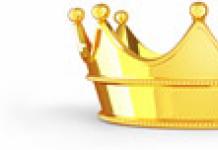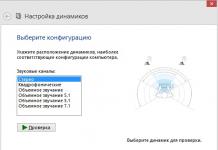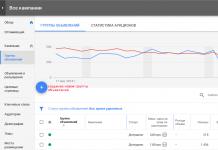Computers, without which our life is not possible, actually appeared not so long ago. Representatives of the older generation not only did not use computers during their studies at schools and institutes, but, as a rule, they had no idea what they were. The era of computers and even electronic computers - computers - as the first computers were called in our country, came into our lives relatively recently. Although their most distant predecessor, the abacus (abacus), appeared in ancient Babylon 3000 BC.
Reconstruction of a Roman abacus
The first person who invented the first digital computing machine was Blaise Pascal. In 1642, he introduced the Pascalina, the first mechanical digital computing device to actually be realized and become famous. The prototype device added and subtracted five-digit decimal numbers. Pascal produced more than ten such calculators, and the latest models operated on numbers with eight decimal places. It all started with this discovery...

Pascal's summing machine
Since then, many mechanical devices have been invented that make it possible to perform not very complex calculations. The main progress was observed from the end of the 19th century, and the peak occurred in the first half of the 20th century. And so, in 1938, the German engineer Konrad Zuse created the more complex first mechanical programmable machine Z1. On its basis, in 1941, he created the first Z3 computer, which has all the properties of a modern computer.
Recreated Z3 at the German Museum Munich
Who and when invented the first electronic computer? After all, it is he who is the real prototype of modern computers. And this happened quite soon after the invention of Konrad Zuse. In 1942, American physicist John Atanasov and his graduate student Clifford Berry developed and began installing the first electronic computer. The work was not completed, but had a great influence on the creator of the first electronic computer, ENIAC. The person who invented the ENIAC computer, the first electronic digital computer, was John Mauchly, an American physicist and engineer. John Mauchly generalized the basic principles of computer construction based on the experience of developing machines, and in 1946 the real electronic computer ENIAC appeared to the world. The development leader was John von Neumann, and the principles and structure of the computer he outlined later became known as von Neumann.

ENIAC computer
So the questions about what year the computer was created, where the first computer was created and who created the first computer can be answered in different ways. If we are talking about the first computer in general (in this case, a mechanical one), then Konrad Zuse can be considered its creator, and the country in which the first computer was invented can be considered Germany. If we consider the first computer to be an electronic computer, then it will be ENIAC, the inventor, respectively, is John Mauchly, and the country is the USA.
The first computers were still far from the ones we use now - personal computers. They were huge, occupied significant areas, comparable to the area of a multi-room apartment, and weighed several tens of tons! Personal computers (PCs) appeared much later.
Who then created the first personal computer? The creation of the first personal computers became possible only in the 1970s. Some people began to assemble computers at home for the sake of research interest, since there were practically no useful uses for computers at home. And in 1975, the first personal computer Altair 8800 appeared, which became the first commercially successful PC. The creator of the first personal computer was the American engineer Henry Edward Roberts, who was also the founder and president of Micro Instrumentation and Telemetry Systems, which began producing the first PC. Altair 8800 was the “chief” of the boom in computerization of the population.

Personal computer Altair 8800
The first personal computers, and even the computers of the early 90s, were many orders of magnitude weaker than modern ones. Suffice it to say that the memory capacity of a modern, not-so-cool “flash drive” is comparable to the entire disk memory of several thousand (!!!) personal computers of the early 90s. And so it is the same for all other indicators. The fantastic leap in the performance of modern personal computers in the 2000s is associated primarily with the development of new technologies in the field of electronics and nanotechnology.
The very first people to whom the word computer was used were people who performed all calculation operations in their heads, and they lived back in 1613. But later, with the advent of the 19th century, humanity began to realize that if machines for computing appeared, they could cope with work faster and would not require rest.
It is believed that the very first computer in the world was created by a mathematician born in England, his name was Charles Babbage. His machine is recognized as the first device capable of automatically performing calculations and printing the results on paper. But due to financial problems, the scientist was never able to create the final version.
The first computers of the twentieth century

Despite the fact that the first development was created a very long time ago, a full-fledged computer was assembled only in 1938. The very first electromechanical binary machine was introduced to the world, and it was invented by Konrad Zuse, a scientist from Germany.
He called this computer Z1, but in the same year another device was built that emulated human actions, which followed a certain algorithm of instructions, and all the results obtained were displayed on a paper tape. This device was called a Turing machine, as it was invented by another scientist, Alan Turing.
The very first computer officially recognized

The officially registered very first computer is considered to be the Mark-1 programmable machine. Initially, her main goal was to serve for the benefit of the military. After a series of tests, which were successful, the computer was put into operation in 1944.
It was created by IBM engineers and Harvard mathematician Howard Aickson. They took the work of Charles Babbage as a basis and began assembling it on the territory of that same Harvard.
The world was presented with both the very first computer and the most expensive one - its price was 500 thousand dollars. The device consisted of more than 760,000 parts, its length was 17 m, and the body was made of glass and stainless steel. Considering the height of 2.5 meters, it was decided to allocate a separate room for it.
As for the remaining characteristics of the very first computer (electronic computer), they are as follows:
- Weight - more than 4.5 tons.
- The total length of cables inside the very first computer was 800 km.
- The length of the synchronizing shaft is 15 meters.
- The power of the electric motor that was used to start the machine is 5 kW.
Some inventors saw the first computer as a large and powerful adding machine. This opinion was held by those people who believed that the ENIAC device became the impetus for the development of all further computers. But the one who invented the Mark-1 is still considered its founder, thanks to the machine’s ability to automatically perform the required tasks.
Note!
Carrying out its work using punched paper tape, the first automatic device required virtually no human intervention in its operation.
The main advantage of the Mark-1 was the ability to perform the following tasks:
- Division – 15 sec.
- Addition and subtraction – 0.33 sec.
- Multiplication – 6 sec.
- Ability to operate with 72 numbers.
But soon the characteristics of the computer did not meet the inflated requirements of customers, so Howard Aiken proposed creating computers of a more powerful and modern type. After that, scientists released 3 more versions of one of the very first computers, the last model of which was created in 1952.
ENIAC

All the first computers were invented for approximately the same purposes. Both in terms of characteristics and external data, they did not differ radically (you can compare “Mark-1” and “ENIAC” using numerous photos from the Internet). But if we talk about the computer created in 1945, it was already distinguished by its multitasking and increased level of capabilities. But since the war was over this year, the car was not used for military purposes.
It was decided to use the machine for other purposes, for example, to simulate the activation of a hydrogen bomb. Although the device was assembled later than its predecessor, the computer was just as huge, but its price was slightly less, and the machine included more than 17,000 lamps in its design. World-famous electronics engineers John Mosley and his partner John Eckert worked on the creation of this giant.
To protect the structure from damage, it was decided to increase reliability by applying the same principle that was used at that time for musical electric organs. This helped to have a positive effect on reducing the accident rate, after which, out of a huge number of lamps, within 7 days, only 2-3 pieces could deteriorate.
At that time, scientists invented the best device for computing, its characteristics were as follows:
- total cost of construction - $487,000;
- weight – 27 tons;
- memorization capabilities – 20 number-letter combinations;
- multiplication speed – 357 different combinations per second;
- summing numbers – 5,000 operations per second.
It took 200,000 man-hours to assemble the world's most advanced computing machine.
Before the ENIAC machine, no computer had ever used a tabulator to enter and exit data from the computer. The only significant drawback of this device was its enormous size and weight - it exceeded the Mark-1 computer by several times in weight and 2 times in size.
EDVAC

Soon Eckert and Mosley began their next invention, the EDVAC. Electronics engineers figured out how to make the first machine that would carry out calculations not only using punched cards, but also relying on programs located in its memory.
These possibilities became available after the creation and further use of mercury tubes. And with the help of the binary system, the issue of computers using a huge number of lamps and the use of complex calculation algorithms was resolved.
Thus, the computer era advanced one more step; the device was assembled from the following elements:
- Timer.
- Devices that allow you to remember information and perform complex calculations.
- A device for receiving signals and further transmitting them to computing modules.
- A device for recognizing information on magnetic tape.
- An oscilloscope that controls the operation of a computer.
- Temporary registers. In the modern world they are called “clipboards”.
The computers that were the predecessors no longer looked like the fastest when EDVAC appeared. To add sums, multiply and divide, a fraction of a second was enough for him, although he still occupied a fairly large area - about 46 square meters. meters. But the number of lamps, compared to ENIAC, decreased by 14,000 pieces, and the power was increased to 50 kW.
Interesting fact!
A little more time passed, and the first game in the world appeared. She was namedSpacewar, and its essence consisted in the struggle of two spaceships that fired missiles at each other.
Quantum computer

Everyone already roughly understands when the first computer appeared, but what about a quantum device? A pleasant surprise was the recent development of Russians and scientists from America. For the first time in the world, they were able to assemble a quantum computer and successfully test it.
At the moment, a more complex quantum device has not yet been created. This kind of large-scale achievement allowed Russian scientists to become leaders in the race to create a full-fledged quantum machine.
Such devices are special computing mechanisms that consist of qubits, in this case 51 pieces, and standard modules for calculations - they store a spectrum of values found in the interval between 0 and 1.
Several other scientists from different countries were preparing to create such a quantum computer. It was believed that the person closest to its creation was Google representative John Martinis.
But still, Russian scientists, together with the Americans, were able to get ahead of everyone. They noticed that sets of atoms that are held inside laser cages and have very low temperatures could be used as quantum qubits. It was the use of this technology in a quantum device that could bring domestic scientists to a leadership position in the world market.
It is not yet known what the situation with the cost of such a machine will be, but one cannot yet expect a low price, given the capabilities and complexity of the device.
Conclusion

The first computers that went on mass sale were devices from Apple - they bore little resemblance to a modern computer. But it is thanks to all the developments of that time that now almost every resident of the country can afford a computer.
Very soon, with the advent of quantum computers, humanity will be one step closer to stunning discoveries and the creation of an ideal computer.
Today, almost every home has a computer, or even more than one. It has become an integral part of our lives, especially with the advent of the Internet. The computer is an assistant in work, a storehouse of information, a way of communication, entertainment... Give us reason, O Universe, so that it never becomes our master!
Now we cannot imagine life without a computer. It is difficult for us today to understand why the older generation cannot master simple actions and treats the computer with some kind of almost biased caution. The younger generation doesn’t even imagine that just recently there were no computers at all!
Who remembers the first PCs? It was such a curiosity! The computer, as such, was cumbersome. The monitor, made like a TV, took up a lot of space and was not color. The programs also left much to be desired (I remember a programming class at school). It was essentially an overgrown calculator. It’s not that there was no talk about laptops or tablets, it was something out of a fairy-tale saucer with a pouring apple.
Yes, it cannot be compared with today's computer. Today's computer almost serves as a “head”, instead of our own, with leaky memory.
But where did the computer even come from? Who invented the computer?
A little history
Perhaps I’ll start with what the word “computer” itself means and what it implies.
So, the word “computer”, as is known from the school course, in direct translation means a calculator. By the way, the word itself is not even from the English language, but a derivative of Latin. And it first appeared in one of the English dictionaries at the end of the nineteenth century. Initially, the word computer meant a profession, that is, a person engaged in calculations using mechanical devices. In the first half of the twentieth century, additions were made to the same dictionary, based on which the word computer became a common noun, denoting the computing mechanisms themselves, and not the person using them.
People all over the world use computers every day to work, communicate, search for information on the Internet, watch movies and TV series, play games and much more. But when and who gave people the opportunity to do this? In the modern world of technological progress, it is difficult to imagine life without a PC. Today's pupils and students cannot imagine life without a computer: writing essays and reports by hand, looking for information in libraries, and not in Wikipedia... So, who and when invented the first computer in the world?
Background
- The answer to the question of when the first computer appeared goes back to the distant past, the main purpose of which was to simplify mathematical calculations. For this purpose, back in the third millennium BC, the very first abacus - abacus(from Latin abacus “board, counting board”). However, they were used rather not to simplify counting, but to remember intermediate values. Abaci can be used to perform four arithmetic operations, as well as to calculate square roots and third roots.
Mechanical and automatic computing machines
- Next on the list of ancestors of the modern PC were the adding machine, designed to accurately calculate four operations, and the arithmograph, a mechanical computing machine that automatically recorded numbers on a special tape. Known throughout the world, Leonardo da Vinci was the one who first depicted a diagram of a mechanism similar to an adding machine, but his ideas did not receive recognition and dissemination.
- The first adding machine in history appeared in mid-1623 - Wilhelm Schickard counting clock. The device consisted of gears connected in series and served to perform addition, multiplication and memorization of intermediate calculations.
- Blaise Pascal’s Pascalina, invented in 1642, had a similar internal structure and was long considered the first mechanical counting device. The adding machine was a box with gears, on the panel of which there were wheels with numbers from 1 to 9, intended for entering numbers to be added. The answer was displayed at the top of the case. Adding machine She knew how to not only fold, although this required some additional effort.
- Also in the 17th century, Leibniz's adding machine (1673) and Moreland's machine (1674) were created. In 1709, Marquis Giovanni de Poleni from Italy introduced his version of the adding machine. In the 50s of the 19th century, Pafnutiy Lvovich Chebyshev created the first adding machine in Russia.
- At the beginning of the 17th century, the English astronomer Edmund Gunther proposed putting a logarithmic scale on a ruler and using compasses to perform addition and subtraction with logarithms. In the 1620s, the English mathematician Edmund Wingate improved this ruler with two additional scales, and in 1622, William Oughtred published his version of the device in the treatise “Circles of Proportions.” Actually, William is considered the author of the first slide rule, which until 1633 was circular. The following improvements are due to Robert Bissacker (1654), Seth Partridge (1657) and Thomas Everard (1683). The familiar slider on the device appeared thanks to the French engineer and mathematician Victor Mayer Amédée Mannheim only in the middle of the 19th century.
- One of the most important steps in the history of the PC was the appearance in 1801 of Joseph Marie Jacquard's punch card, used for automatic data processing. This card is the first version of modern binary code that uses the presence or absence of holes in the cardboard instead of zeros and ones. Joseph used such a device to automatically control patterns on fabrics in weaving machines.

- The work of bookkeepers was greatly simplified when in 1822 the English mathematician Charles Babbage constructed a model of a difference engine, the first idea of which belongs to the German engineer Johann Muller and dates back to 1788. The mechanical apparatus was called Charles Babbage's Analytical Engine and served to automate calculations by successively approximating functions with polynomials and calculating finite differences.
Difference machine
Thanks to the opportunity to represent logarithmic and trigonometric functions in polynomials, this device is a fairly universal computing tool and can thus replace up to 20 accountants with manual adding machines. Some time later, Martin Wiberg from Sweden improved the device and used it to calculate and publish logarithmic tables.
History of the invention of the computer




Electromechanical computing tools
- The first electromechanical device to carry out calculations was a tabulator built by the American Herman Hollerith, designed to speed up the processing of the results of the 1890 census in the United States. The machine summarized and sorted information written in numbers or letters on punched cards, and produced the result on a paper tape or special forms. Such devices were used for a long time to process arrays of information before electronic computers became widespread.

- The breakthrough was invention of the German engineer Konrad Zuse Z3, created in 1941. This device was the first fully functional software-controlled and binary-coded machine and had the properties inherent in a modern PC. Three years before the introduction of the Z3, Zuse introduced the Z1 to the world, which was limited in programmability and differed mainly from the final model in the absence of a square root function. In 1939, the engineer completed the second version of the computer, which became the world's first electromechanical computer put into operation. the very first computers in the world.
The success of creating devices was the implementation of their work in the form of a binary system, which by the 20th century was not something supernatural, but Conrad managed to combine the knowledge of other scientists and create on their basis the first programmable computer.
- On August 7, 1944, at Harvard University, after passing a series of successful tests, the first American fully programmable computer, the Mark 1, which did not require human intervention, was launched. automatic calculator, driven by sequences. The machine was developed and created in 1941 under an agreement with IBM based on Babbage's developments.

Actually "Mark 1" is an improved manual adding machine, but thanks to its programmability, many call it the first truly working computer. The machine read information from a perforated tape, and cyclic processes were performed by closing the beginning and end of the tape being read.
Electronic computers
- The concept of “electronic computer” should be distinguished from the broader “computer”, since a computer implies the use of electronic components as functional units, while calculations can also be performed in a number of other ways. The first computers were ENIAC (1946, USA), Manchester Small Experimental Machine, also known as Baby (1948, UK) and EDSAC (1949, UK).
- April 7, 1964 IBM announced the creation of System 360 computers. This series subsequently became an example of an open standard, in other words, the compatibility of equipment made by different manufacturers. All models, regardless of their size and shape, had typical details. Thus, the customer could purchase a relatively budget model and, if necessary, upgrade it to a larger system in the future. In fact, it was IBM/360 that set the 8-bit byte standard and introduced the hexadecimal number system into widespread use in programming, and also became the first 32-bit computer system.
Personal computers
- A personal computer (PC or PC - personal electronic computer), so familiar to modern people, is a desktop micro-computer, which is a household appliance with universal functionality.
- The first PC was the H316 Desktop Computer, released by Honeywell in 1969. The device cost $10,600 and weighed as much as 45 kg. One of the main purposes of this device was to store various recipes, hence the second name “Kitchen Computer”.
- A decisive role in the emergence of the PC was played by the invention of the i4004 microprocessor by Intel employees in 1971, which could reproduce all the functions of a large computer processor in one chip.
Can you imagine the modern world without computers? I don’t, because every step we take is connected with computers. This story began back in the distant 40s, when the world was just beginning to learn about the creation of the first “computers” (electronic computers).
The history of the creation of the world's first computer
In 1942, John Mauchly's project gave impetus to the creation of the first computer, although at first no attention was paid to the project itself. One day one of the US Army laboratories became interested in it, and already in 1943 the first steps were taken to create a machine called “ENIAC”. The money for the creation was given by the Pentagon (which needed to create new guns), and it cost a little less than $500,000.

By the way, ENIAC turned out to be very voracious in terms of electricity, when it was turned on - the lights of the nearby city dimmed every time. ENIAC (Electronical Numerical Integrator and Calculator) was truly the first computer that could be programmed.
Technical characteristics of the first computer:
- Weight reached 27 tons;
- Power - 174 kW - this is approximately how much a huge shopping center consumes on a weekend;
- Contained 18,000 vacuum tubes, because there were no transistors and processors at that time;
- Memory - 4 kilobytes;
- Its size was impressive - it occupied 135 sq.m.
- Performed up to 5000 actions per second.
The most amazing thing is the kilometers of wires that were wrapped around the computer. It was programmed as a telephone communicator, operated by telephone operators.

Later, it began to be used not only to analyze cosmic radiation, but also to create a hydrogen bomb. While the computer was being created, the war ended, but research did not stop and in 1945 they conducted the first official test, which it passed. At the same time, about 1,000,000 IBM punch cards were processed. Despite its enormous size and weight, the computer worked for about 10 years.
Five years later, the transistor was invented, which marked the beginning of the reduction in the size of computers.

Where and when was the first personal computer sold?
The concept of the personal computer changed little over the next two decades. The introduction of the microprocessor speeded up the process of creating a computer. IBM tried to create its first computer back in 1974, but the attempt failed and sales were very low. IBM5100 - had cassettes as storage media, rather light weight and a serious cost of $10,000.

He was also already able to independently execute programs written in programming languages such as BASIC and APL (he was created at IBM). displayed 16 lines of 64 characters, memory about 64 KB, and these cassettes were similar to stereo audio cassettes. But sales never came because there was no normal interface provided and the price was too high.
Have you ever wondered what computers will be like in 10 years?
IBM recently unveiled its new mega-computer, the Roadrunner. Its capacity is 1,000,000,000,000 (1 quadrillion) operations. It was created for the US Department of Energy, and consists of 6480 2-core processors, and 12,960 processors from IBM, which are called . It includes 278 huge cabinets, 88 kilometers of cables, weighs 226 tons, occupies an area of 1100 m², consumes 3.9 MW, and costs $133,000,000.



























